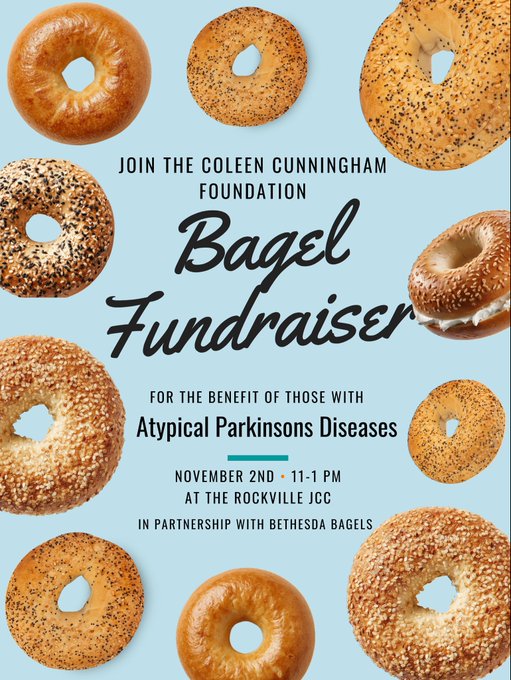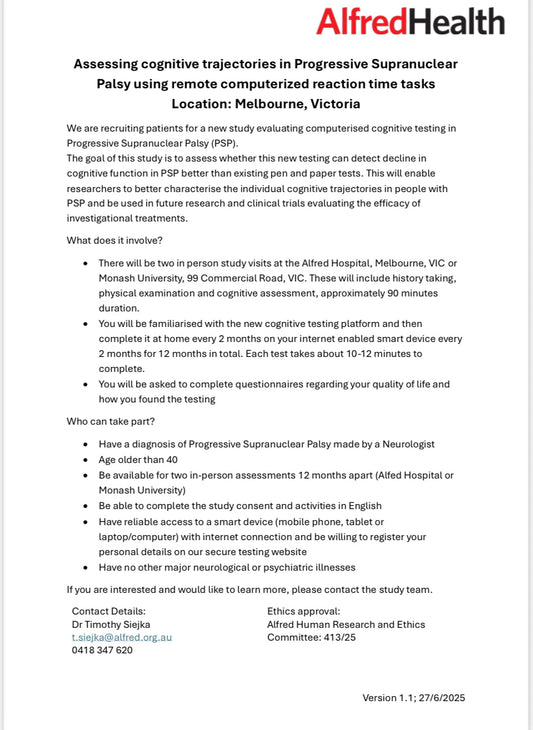It has been said there are four stages, but because there is so little research they are a guideline only.
Many people experience some stage four symptoms at stage one or overlap stages. Some never experience certain symptoms and then others can experience ones not listed. The impact it has on each individual varies dramatically.
Progressive Supranuclear Palsy (PSP) is a rare neurodegenerative disorder that affects movement, balance, vision, speech, and cognitive function. The disease progresses slowly over time, and its symptoms typically become more severe as the disease advances. While not everyone with PSP experiences the same symptoms or progression, there are generally four recognized stages of PSP:
-
Early stage: In the early stage of PSP, individuals may experience symptoms such as difficulty with balance and coordination, changes in gait, and problems with eye movement. These symptoms may be subtle and easily dismissed as normal aging or a different condition.
-
Mid-stage: In the mid-stage of PSP, symptoms become more pronounced and can include falls, speech and swallowing difficulties, and cognitive impairment such as problems with memory and executive function. Depression and apathy are also common.
-
Advanced stage: In the advanced stage of PSP, individuals may become wheelchair-bound and require assistance with daily activities such as eating, dressing, and bathing. Symptoms such as rigidity, spasticity, and involuntary movements become more severe.
-
End-of-life stage: In the end-of-life stage of PSP, individuals may be bedridden and require around-the-clock care. They may have difficulty swallowing, become more susceptible to infections, and experience other complications related to the progression of the disease.
It's important to note that not everyone with PSP will experience all of these stages, and the progression of the disease can vary widely from person to person. Additionally, some individuals may experience rapid progression, while others may experience a slower course of the disease.
Here is the four stages below in more detail;
Early stage:
May present via the fracture clinic, falls services, eye specialist or speech and language therapist. The early stage typically spans years 0-1.
> Ambulant.
> Occasional falls.
> Unsteadiness and poor balance.
> Possible visual problems affecting ability to read.
> Voice changes, for example reduced volume.
> Mood changes.
> Reduced socializing.
> Changes in mood and behavior, including apathy and anxiety.
Mid stage:
Many people reach this stage before diagnosis. Consider discussing advance care planning and advance decisions to refuse treatment. Consider referral to palliative care services. The mid stage typically spans years 2-3.
> Ambulant with aids.
> High risk of falls and injury.
> Visual problems affecting self-care abilities, for example eating and walking as unable to move eyes to see.
> Speech increasingly unintelligible.
> Inability to initiate conversation.
> Impulsivity (risky or impulsive behavior).
> Apathy.
> Dysphagia.
> High level of supervision required.
> Increasingly socially withdrawn.
Advanced stage:
Patients should be on GP palliative care register and have access to specialist palliative care.
The advanced stage typically spans years 3-6.
> Mobility significantly compromised, probably chair bound requiring a wheelchair for mobility.
> Significant visual problems.
> Significant muscle stiffness.
> Significant communication problems, but probably still able to understand.
> High risk of aspiration and pneumonia as a result of dysphagia.
> Pain.
> Increasing periods of sleepiness.
> Incontinence.
> Severely withdrawn socially.
> Dependent for most or all aspects of care.
End of life stage:
This stage is difficult to detect, but may be indicated by reduced levels of consciousness, inability to eat or drink, acute infection, a fall or major fracture, and rapid and significant weight loss. The end of life stage typically spans 6-8 weeks.
> Severe impairments and disabilities.
> Rapid and marked deterioration in condition.
> Decisions with regard to treatment interventions may be required, considering an individual’s previously expressed wishes (advance decisions to refuse treatment).
Discover the Benefits of Vielight Red Light Therapy for Atypical Parkinsonism


 Donate
Donate




131 comments
My sister has just died with PSP, heartbreaking to see her suffer through this, we noticed a hand tremor at first, but then we related a few earlier instances, not being able to dance, leaning back, struggling with some things, first treated for parkinsons but then the symptoms came on strong and was then diagnosed with PSP, she did really well fighting it and did get lots of help, her husband cared for her and kept her going, then came loss of speech, eye movement, needed help to get about, but still kept going the best she could, then total loss of speech and then could only do thumbs up or thumbs down, then incontinent , then could not swallow, could not eat, the weight loss was staggering, then came a stay in a home for respite , then hospital stay, then she got worse if that was even possible, I felt that she could still understand everything and would move a little to emmerdale , love island and some music, then she went quiet, no food no drink, i held her hand, rubbed her back, stroked her arms, talked about all we had done, put loads of positive things in head, so weak, so tired after two weeks she left us, this a rare disease – what links all the people that get this, what common thing sends you down this path… i imagine my sister free from that body and laughing loudly again, god bless those that get it and the family and friends who have to stand by helpless i send the love that my sister would have sent you, to help you get through
My sister has just died with PSP, heartbreaking to see her suffer through this, we noticed a hand tremor at first, but then we related a few earlier instances, not being able to dance, leaning back, struggling with some things, first treated for parkinsons but then the symptoms came on strong and was then diagnosed with PSP, she did really well fighting it and did get lots of help, her husband cared for her and kept her going, then came loss of speech, eye movement, needed help to get about, but still kept going the best she could, then total loss of speech and then could only do thumbs up or thumbs down, then incontinent , then could not swallow, could not eat, the weight loss was staggering, then came a stay in a home for respite , then hospital stay, then she got worse if that was even possible, I felt that she could still understand everything and would move a little to emmerdale , love island and some music, then she went quiet, no food no drink, i held her hand, rubbed her back, stroked her arms, talked about all we had done, put loads of positive things in head, so weak, so tired after two weeks she left us, this a rare disease – what links all the people that get this, what common thing sends you down this path… i imagine my sister free from that body and laughing loudly again, god bless those that get it and the family and friends who have to stand by helpless i send the love that my sister would have sent you, to help you get through
My mother was diagnosed with PSP yesterday. We have been trying to get a diagnosis for her for the past four years. She is in the end stages and has been turned over to palliative care. She started with falling and fractured her leg about three years ago, she continued to fall after rehab so we decided to put her in a wheelchair about a year ago and she started showing signs in her Voice, she also could not communicate as well as she would have trouble thinking of the words to say to explain how she feels or what she needs. She talks very quiet and it is hard to understand what she is saying. She has no balance she has to sit in a special chair that keeps her tilted back. She cannot hold her head up and she cannot look down. She has muscle trimmers and now she is on a puree diet and chokes easily and sleeping a lot more. She has lost over 50 pounds in the last year. This is a terrible disease and so heartbreaking to watch your little one go through and there’s nothing we can do to help them, but keep them comfortable. Prayers for everyone who is dealing with this with their family or friends.
How can I help a friend who was diagnosed 2 years ago, is now in hospice care, difficulty walking, speech is slow and difficult to comprehend.
How can I help a friend who was diagnosed 2 years ago, is now in hospice care, difficulty walking, speech is slow and difficult to comprehend.